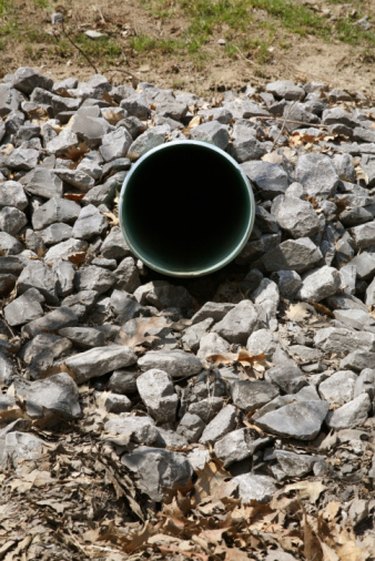Things You'll Need
Wood stakes
Hammer
Tape measure
String
String level
Permanent marker
Trench digging tool
Pea gravel
Landscaping fabric
4-inch polyethylene perforated corrugated drainage pipe
Coarse sand

A French drain is a shallow drainage system involving a perforated, corrugated pipe placed about a foot below the surface of the ground, in a gravel-filled trench and on a slight slope. As water filters through a top layer of coarse sand and into the drainage pipe, it is directed away from an area where the water could damage a home's foundation, garden or other structure.
Step 1
Examine the area around your property an hour after a heavy rain storm. Locate the areas where there is standing water or where the ground is swampy. Determine the drainage path by starting at the highest point where you want to relieve potential flooding and going to the lowest point, which is where you want the water to exit.
Video of the Day
Step 2
Take a wood stake and hammer it into the ground at the highest, uphill point of the planned drainage path. Measure 6 inches up from the ground and tie string around the stake at this height. Hammer another stake at the end of the drainage path. Pull the string taught and tie it around this stake.
Step 3
Attach a string level to the string and move the string up or down on the bottom stake until the string is level. Make a mark on this stake at the point where the string is level with a permanent marker.
Step 4
Measure the distance of the drainage path from the uphill stake to the bottom stake. Lower the string on the bottom stake 1/4 inch for every 25 feet. For example, if the distance is 50 feet, lower the string on the bottom stake 1/2 inch. This ensures you have the proper slope for efficient drainage.
Step 5
Dig a trench 6 inches wide and 12 inches deep from the uphill stake to the bottom stake with a trench digger. Take several measurements along the string line to the bottom of the trench with a tape measure. The measurement from the string to the bottom of the trench should be a constant 12 inches from one end of the trench to the other to ensure the proper slope. Add or remove soil to make any adjustments.
Step 6
Pour 2 inches of pea gravel into the bottom of the trench. Lay landscaping fabric on top of the ground next to the trench. Place a 4-inch polyethylene perforated corrugated drainage pipe on top of the fabric. Wrap the fabric all the way around the pipe. This prevents dirt from entering and clogging up the pipe. Lay the wrapped pipe on top of the gravel in the trench.
Step 7
Pour more pea gravel around and on top of the pipe. Top off the trench with a 3-inch layer of coarse sand.
Tip
Call local city offices before digging to check for underground pipes and utility lines.
Warning
Avoid having the drain directed toward your neighbor's property. Direct it toward a stream, ditch or toward the street.
Video of the Day